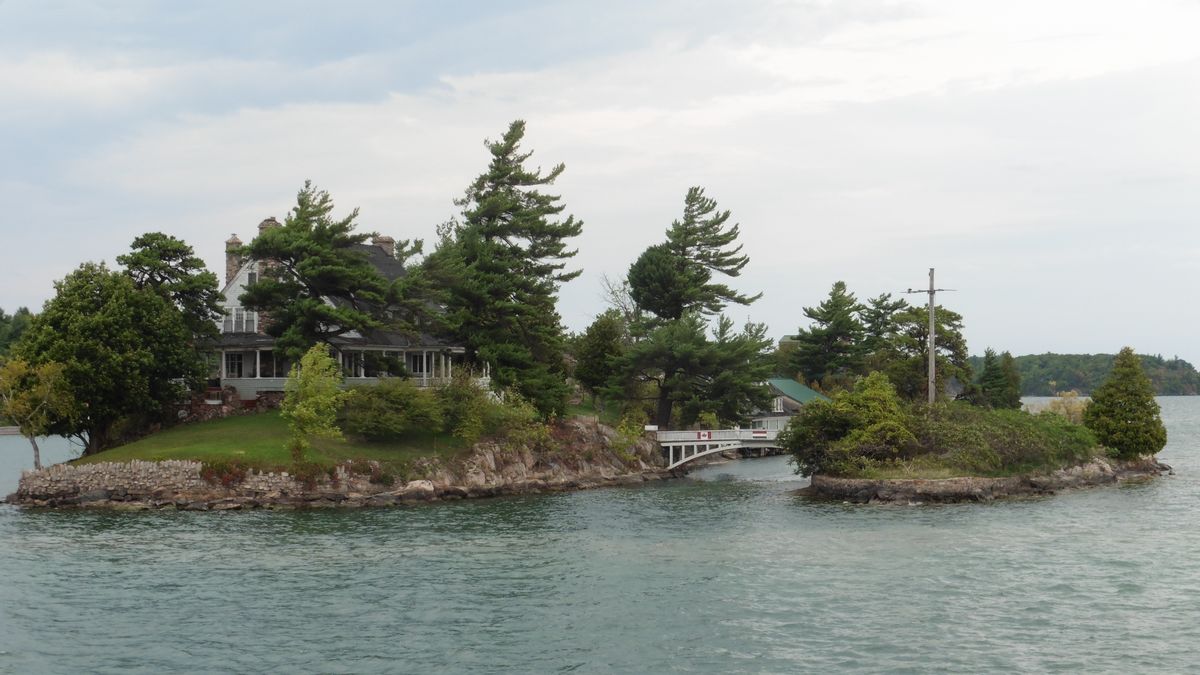The bridge is real, connecting Ontario's Zavikon Island with a smaller island. However, the passageway is not the "world's shortest international bridge" because it does not cross the Canada-U.S. border. Rather, the bridge and the islands are located exclusively in Canada. Also, the claim that one person's residential property spans both islands was unsubstantiated.
Online posts suggest a small, 32-foot-long bridge between two islands is the "world's shortest international bridge" that connects a "homeowner in Canada to his backyard in New York."
The bridge is real, connecting Ontario's Zavikon Island with a smaller island. However, the passageway is not the "world's shortest international bridge" because it does not cross the Canada-U.S. border. Rather, the bridge and the islands are located exclusively in Canada. For that reason, Snopes rated this claim "False."
While the property does exist, Snopes was not able to confirm or disprove the claim that one person's residential property spans both islands.
Snopes reached out to the Canadian government (specifically, the agency that helps the federal government manage properties) for more information about the islands, including whether it was true they are one person's residential property. We also asked whether it was possible that the U.S.-Canadian border may have changed over the decade and at one point the islands were separated by it. We will update this article if we receive a response.
That said, Alexandre Baillairgé-Charbonneau, a spokesperson for the Canadian government, confirmed the "bridge between Zavikon Island and the smaller one is within Canadian boundaries."
A look at Google Maps and the Canadian Geographical Names Database — Canada's official database of locations' names and their attributes — showed Zavikon Island within the boundaries of Ontario in the Saint Lawrence River. Meanwhile, Zavikon Island is about 1,800 feet from Huguenot Island, one of the nearest parcels of land in the neighboring U.S. (New York state, specifically).
 (Google Maps)
(Google Maps)
Zavikon Island, known previously as Aspasia Island, is located in the Thousand Islands — which, according to the 1000 Islands Tourism Council in the U.S, is a "sightseer's paradise" that is "located along the peaceful border" between New York and southeastern Ontario. Despite the region's name, it actually covers 1,864 islands that span more than 50 miles of water. According to the tourism website:
To be considered an island, it has to stay above water 365 days a year and support a living tree. Many are open to the public and are home to parks, campgrounds and cottage rentals. Wellesley Island (United States) is connected to the U.S. and Canadian mainland by the Thousand Islands International Bridge. Wolfe, Howe and Simcoe islands (Canada) are reachable by ferries. Thousand Islands Islands National Park (Canada) is a group of 21 islands along the 1000 Islands Parkway, Ontario, that are open to the public.
According to the Gananoque 1000 Islands Visitor Center in Canada, the notion of Zavikon Island's bridge straddling two nations is a "popular but incorrect tale." Zavikon Island is "entirely located in Canadian territory."
As the travel journalism website Atlas Obscura reported in June 2013, the story of Zavikon Island "goes back to the late 19th century with the tiny bridge between the two islands said to be the shortest international crossing in the world." For instance, a 1910 image that's in the public domain purportedly shows the two islands "with Canadian and American flags" on their respective islands:
 (Public Domain)
(Public Domain)
According to Sovereign Limits, a database that provides information on international borders, the U.S.-Canada border was originally established by the 1783 Treaty of Paris. Since then, it's been revised nearly a dozen times. It's possible that the boundary near Zavikon Island may have shifted at some point during the 20th or 21st centuries.
In addition to the Canadian government, Snopes contacted the New York State Office of Parks, Recreation, and Historic Preservation to ask questions about the bridge and nearby border. We will update this article accordingly.
That said, a flag flying on a private residence does not necessarily indicate the property's country.
Another image hosted by Wikimedia Commons showed the bridge in a 2016 photo. The image did not show any signs of digital manipulation — that is, it appeared to be an authentic documentation of the bridge. In that photo, the bridge's railing displayed Canadian and American flags, as well as what appeared to be Hungary's flag. The latter country is located on another continent entirely.
 (Public Domain)
(Public Domain)

